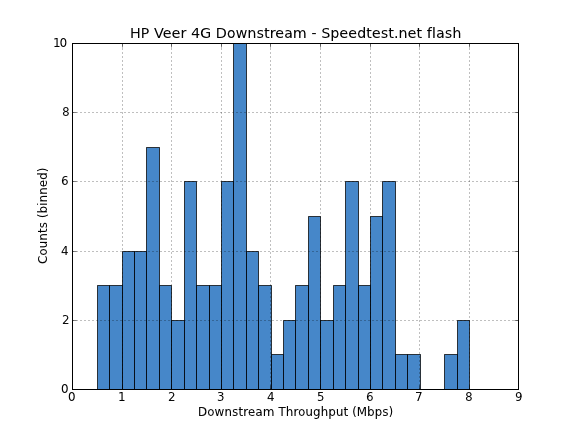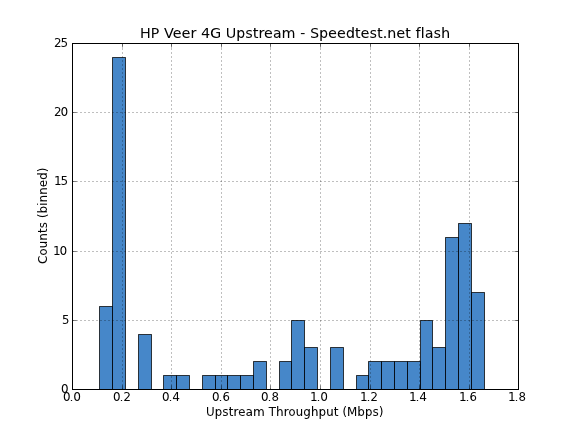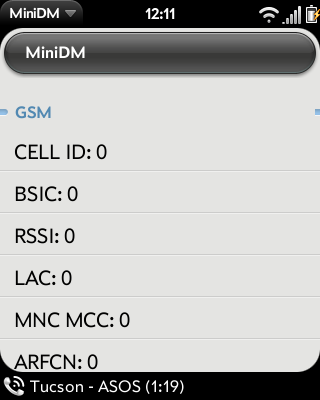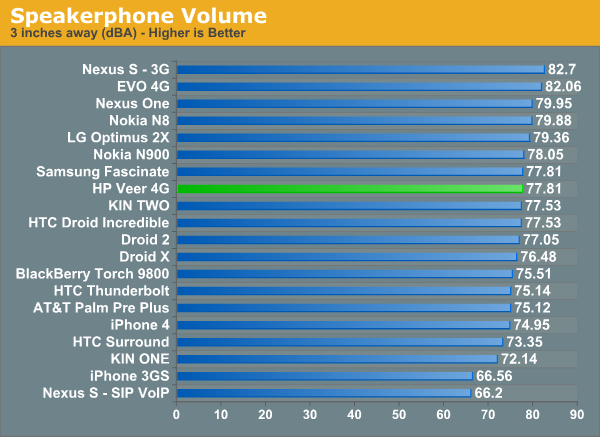HP Veer 4G Review - Getting Us Excited for Pre 3
by Brian Klug on June 7, 2011 5:01 PM EST- Posted in
- Smartphones
- HP
- AT&T
- Palm
- veer
- webOS
- HSPA+
- Mobile
- HP Veer 4G
So how does this all loop back to cellular networks? Well the modulation schemes we’ve described here are what are at play right now in cellular networks. In the beginning of WCDMA, in 3GPP Release 99, the only modulation scheme was QPSK. Later in the HSDPA release-5 standard, 16QAM was added, and finally in release-7, 64QAM was added. That’s all only talking about the downlink from the tower to the handset. That said, the same gradual addition of higher and higher order modulation has taken place on the uplink as well, with the new addition of 16QAM in release-7 to supplement existing QPSK from release-6. User equipment continually reports its own downlink quality measurement to the tower in uplink signaling, and the tower makes its own decision about what modulation scheme to use depending on link quality. When quality is very good, 64QAM gets used, else 16QAM, else QPSK.
The addition of 64QAM thus makes it possible to achieve much higher data rates, but only close to the cell center where there’s minimal interference or noise, or good Signal to Noise Ratio (SNR). There’s been some drive testing done which shows that in real world environments, 64QAM only gets used around 10% of the time – it isn’t something used a lot of the time by any stretch of the imagination.
So what’s the confusion here relating to the Veer? It stems from an incorrect assumption about what is and isn’t mandatory in ‘HSPA+’ 3GPP release-7. It is a gross oversimplification of the standard to call HSPA+ merely the previous release with 64QAM added in. The reality is that there are many more things included in release-7, including MIMO user equipment categories that lack 64QAM, numerous layer two enhancements, improved signaling which increases data rate, reduces signaling load, and speeds up state transitions, and the already mentioned changes to upstream modulation (inclusion of 16QAM). Even beyond release-7 is release-8, which adds dual carrier HSDPA, essentially enabling the modem to use two 5 MHz WCDMA downstream channels at the same time, doubling performance. That comes in release-8, and there are categories with all the bells and whistles - MIMO, 64QAM, and/or dual-carrier. I've put together a table with all of the user equipment categories for releases 5 through 7.
| HSDPA User Equipment (UE) Categories, Modulation Scheme, Max Data Rate Table | ||||||||||
| 3GPP Rel. | UE Category | Max number of HS-DSCH codes | Minimum inter-TTI Interval | Maximum Data rate (Mbps) | Modulation Schemes Used | MIMO Y/N | ||||
| 5 | 1 | 5 | 3 | 1.22 | QPSK, 16QAM | N | ||||
| 5 | 2 | 5 | 3 | 1.22 | QPSK, 16QAM | N | ||||
| 5 | 3 | 5 | 2 | 1.82 | QPSK, 16QAM | N | ||||
| 5 | 4 | 5 | 2 | 1.82 | QPSK, 16QAM | N | ||||
| 5 | 5 | 5 | 1 | 3.65 | QPSK, 16QAM | N | ||||
| 5 | 6 | 5 | 1 | 3.65 | QPSK, 16QAM | N | ||||
| 5 | 7 | 10 | 1 | 7.21 | QPSK, 16QAM | N | ||||
| 5 | 8 | 10 | 1 | 7.21 | QPSK, 16QAM | N | ||||
| 5 | 9 | 10 | 1 | 10.13 | QPSK, 16QAM | N | ||||
| 5 | 10 | 15 | 1 | 13.98 | QPSK, 16QAM | N | ||||
| 5 | 11 | 15 | 2 | 0.91 | QPSK | N | ||||
| 5 | 12 | 5 | 1 | 1.82 | QPSK | N | ||||
| 7 | 13 | 5 | 1 | 17.64 | QPSK, 16QAM, 64QAM | N | ||||
| 7 | 14 | 15 | 1 | 21.1 | QPSK, 16QAM, 64QAM | N | ||||
| 7 | 15 | 15 | 1 | 23.37 | QPSK, 16QAM | Y | ||||
| 7 | 16 | 15 | 1 | 27.95 | QPSK, 16QAM | Y | ||||
| 7 | 17 |
15 |
1 |
17.64 23.37 |
QPSK, 16QAM, 64QAM QPSK, 16QAM |
N Y |
||||
| 7 | 18 |
15 |
1 |
21.10 27.95 |
QPSK, 16QAM, 64QAM QPSK, 16QAM |
N Y |
||||
| 8 | 19 | 15 | 1 | 35.28 | QPSK, 16QAM, 64QAM | Y | ||||
| 8 | 20 | 15 | 1 | 42.20 | QPSK, 16QAM, 64QAM | Y | ||||
| 8 | 21 | 15 | 1 | 23.37 | QPSK, 16QAM | N | ||||
| 8 | 22 | 15 | 1 | 27.95 | QPSK, 16QAM | N | ||||
| 8 | 23 | 15 | 1 | 35.28 | QPSK, 16QAM, 64QAM | N | ||||
| 8 | 24 | 15 | 1 | 42.20 | QPSK, 16QAM, 64QAM | N | ||||
Implement any one of the features from release-7 in your modem, and it is considered HSPA+. With respect to the Veer, the features from release-7 HSPA+ that are implemented are reduced cellular signaling for faster call setup, state changes, and less latency. The Veer is based around Qualcomm’s MSM7230 and uses its integrated cellular baseband, which supports HSDPA 14.4 and HSUPA 5.76, which means it supports up to 16QAM on the downlink, and QPSK on the uplink, but still is an ‘HSPA+’ modem due to the improved signaling. Again, it’s an incorrect and gross oversimplification to draw the line based on the lack of 64QAM on the downlink. It’s similarly puzzling why if we’re drawing lines in the sand based on modulation support that uplink modulation wasn’t considered. Education is the only way to mitigate such confusion.
That said there are other HSPA+ modems that do include 64QAM support on the downlink, the earliest of which that I’m aware of is Samsung Galaxy S 4G. That particular phone had an ST Ericsson THOR 5730 baseband with HSDPA 21.1 support. That same modem is likely in the Galaxy S 2 (which we haven’t played with in detail yet) and the Samsung Infuse 4G I have sitting on my desk for an upcoming review. That particular baseband is HSDPA 21.1, HSUPA 5.76, meaning it supports up to 64QAM on the downlink, but again only QPSK on the uplink, yet there aren’t similar confusing rumors about it not being HSPA+.
I’m not even touching on whether HSPA+ should be considered “4G” or not, as that’s an entirely different argument, this is purely about whether or not certain UE categories are part of release 7, and thus HSPA+. Long story short, the HP Veer 4G is definitely an HSPA+ device.
I did the usual due diligence and ran just above 100 speedtests on the HP Veer 4G. One interesting thing I did notice is that using the provided SIM, the Veer’s cellular connectivity indicator stayed on “3G.” The times that I used it with my own SIM for testing (we try to use each device as best we can as our own during testing periods), I saw “H+” which AT&T is showing on a number of devices. I’m definitely intrigued by why there would be any discrepancy since there shouldn’t be any difference, yet I saw this behavior all of my time with the Veer. Speeds with either inserted were virtually the same.

You can see our breakdown the usual histogram view we’ve been presenting since our LTE investigation. Speeds on HSPA+ are definitely faster than EVDO, but still nowhere near LTE. I saw a maximum throughput result of just over 8 Mbps down, which I think to date is the fastest I’ve seen AT&T in my area. Throughput testing on the Veer was performed by running speed tests over flash to speedtest.net and then exporting results at the end.



I'm starting to see this very bimodal distribution of upstream speeds (clustered around 384 kbps for just WCDMA upload when no HSUPA is working, and around 1.5 Mbps when HSUPA is working). I'm beginning to think AT&T is doing something interesting here, but that's for another story.
We’ve been measuring signal attenuation with devices for some time now. Unfortunately WebOS 2.0 seems to do away with MiniDM, the 3G radio engineering application which was what I used on the Palm Pre Plus and other WCDMA WebOS devices.


Firing that up now shows null or 0 values in all fields, likely because it hasn’t been updated to measure anything from Qualcomm’s modem in the MSM7230. Unfortunately I am not aware of any other way to get RSSI from the device. That said, I didn’t notice the Veer being any more prone to deathgrip than any other phone. The only other missing piece that I still have a gripe with in WebOS is the absence of any 3G/WCDMA or 2G/GSM/EDGE toggles. There's absolutely no control over which the device is going to prefer, which was a problem on the GSM Palm Pres as well. More control is always in the interest of users.

I was a bit worried about speakerphone volume on the Veer due to its miniscule size. Incredibly, audio loudness on speakerphone is middle of the pack and totally adequate. Handset audio quality is also very good from what I could tell.










25 Comments
View All Comments
peskypescado - Tuesday, June 7, 2011 - link
I have been a webOS user for a couple of years now and I can tell you that the Touchstone definitely charges _significantly_ faster than the same AC charger just plugged into the phone via microUSB. I'm not sure exactly why, but it is consistently faster on both of the Pre's we have at my house. For me, it is a bigger benefit for why I use a touchstone than the convenience of just being able to set my phone down.Brian Klug - Tuesday, June 7, 2011 - link
Interesting - I mean that definitely bears itself out in the results. I originally ascribed the differences to just charging management, but there definitely seems to be something said for the touchstone charging faster. I'll see if I can find more.-Brian
Johnmcl7 - Tuesday, June 7, 2011 - link
I'm guessing as SE devices rarely seem to get mentioned here that they're just not available in the US? Their X10 Mini Pro is a very similar design and size to the Veer although I think SE's design is better in a few ways, they've gone for a horizontal slider (or whichever way round it is when you turn the phone 90 degrees to use the keyboard) which gives more room and makes for a better keyboard. The keys are well spaced and have a solid 'click' when pressed so that despite its size it works well, better in fact than some of the bigger qwerty devices I've used. The X10 Mini Pro has a 3.5mm port onboard and a micro USB port (for data and charging) plus the back is removable to get access to the user-replaceable battery and has expandable storage through microSD.Unfortunately it's also an ARM11 SoC although it's driving a small screen compared to other smartphones, SE's customisation on top of Android is a bit messy in places as well although in general performance isn't bad. The phone seems to have had reasonable appeal, it's particularly popular amongst my female friends looking for a small phone to slip in a handbag/pocket.
John
Penti - Wednesday, June 8, 2011 - link
Yes they have, but the SE X10 Mini Pro isn't a fluid phone in regards to performance and it's not that hard to use the gd 3.5 mm adapter you snap on, or a USB-charger & data cable both included in the box. It's not that you can't use those.However the X10 Mini Pro is or was available directly from SE, or from Verizon and AT&T. So on. But the new Xperia Mini Pro should come any day. And it's hardly the only cell phone with a slide out keyboard.
As a Swede I would just say stay away from SE basically. They are not up to the task and un-updated software is just a pain. I wouldn't want to use timescape either. It's basically in regard to the X10 mini a phone even too weak for Angry birds.
The guys working in Lund for SE would probably do a lot better job at one of the Chinese manufacturers any way. Nobody in China will miss their factories either. It's virtually a collapse business and has been for years any way. Seriously they are not competitive, and in the states you got stuff like Motorola Milestone/Droid and Droid 2, and so on that's popular instead I guess. The SE's might fit the people who only text and so on. But that misses the point, and it's overpriced and old legacy stuff by now.
Johnmcl7 - Thursday, June 9, 2011 - link
Of course it's not the only phone with a slide out keyboard but it's one of the few that's so small. As a non-Swede I think the advice to stay away from SE odd, there's not many phones like the X10 Mini Pro and it has the Veer beat in just about every way going despite the SE being a much older phone. I haven't seen these 'fluid' problems you mention and the phone is popular amongst my female friends.John
Penti - Friday, June 10, 2011 - link
It's an abandoned phone by now any how. If the Xperia Mini Pro will be any good I don't really know, but it can't be worse and is out any day.As I Swede I'm proud of Ericsson and so on in the telecom industry, they are good and successful, still have manufacturing in Sweden for that matter, but simply not SE. SE is one of the failed mobile brands to begin with, they sell roughly half as many phones as 2007, they are among the ones that have gone bad together with Motorola which collapsed al together but with products looking strong even though they are at about 20% of their 2007 volume and less then that of their 2006 volume (which are just begin to sell again in Sweden mind you at least they are looking up), LG that has stopped growing, SE isn't that respected. Something like Motoblur I would probably prefer over Timescape as it's less intrusive. SE has really screwed up with their software and launcher. I'm fine with running the stock UI and launcher, but you don't really have that choice from mentioned brands.
But hey, at least the new Mini Pro doesn't look like it's from <2009.
It's however a common problem with games and other software lagging on the X10 Mini Pro. The UI has pretty much constantly had performance problems. I.e. not being fluid. (Doesn't mean all users experienced it or that they experienced it over all time they had the phone.) They have messed it up so many times on the firmware side. It's simply not recommended for smart phone usage here.
However a slim company like SE with no software expertise or manufacturing expertise and not much to speak of wouldn't be a loss if they disappeared. They are just building phones with Qualcomm chipsets and not contributing much, they need to pick up if they want to continue delivering phones. They might manage to do it with their revised software on Gingerbread+ but that remains to be seen.
A X10 Mini Pro is however about the same size like something like this HP Veer though, or other non-keyboard smartphones for that matter (X10 Mini non-pro is the one that sold here in Sweden and that Three etc peddled.). I simply wouldn't recommend the X10 Mini to anybody for that matter. 320x240 is simply not suitable for smart phones. The new model will also be a 3" phone although about the same physical size so it's not really that significantly smaller then any other phone. Smaller then the Desire Z and equivalents yes. Old device is simply not in the same league as this HP Veer or most smart phones, small or large. New Xperia Mini Pro however looks much improved. Not saying HP Veer is a feature phone replacement for the same crowed however. SE's device is clearly trying to grow up though. But at 320x480 is still aimed at low-end users.
Not that I like using Android in landscape mode however. I think a vertical slider is much better in most cases, however on phones like N900, E7 (Nokia) I would prefer the landscape mode and keyboards. However if you like an Android with horizontal keyboard there is lot of others to choice from other then SE, I did think about buying one even though the X10 Mini wasn't in question then do to it's software troubles. Anywhere from Motorola, Samsung, LG or a few other devices in the unites states, where you often have branded devices like T-mobiles (HTC) G1 and G2 and MyTouch series. I don't see SE filling a space there really even though it's sold by the operators and stores there. While here in Europe we haven't seen as many choices.
jnmfox - Tuesday, June 7, 2011 - link
"...still thicker..., which is perhaps an even more important criteria for female shoppers.""Whether the Veer goes in the front pocket or is small enough to make it into the back pocket is ultimately a matter of clothing choice and personal preference."
"I will say that it’s refreshing to carry something around that doesn’t weigh my pants down"
robinthakur - Wednesday, June 8, 2011 - link
It's all rather sexist tbh. Lots of men don't want a massive brick of a phone and value a slimline handset that can fit in skinny jeans or tailored jackets without ruining the lines. It's not just a girl thing. This often seems to come up on tech sites, and seems to assume and imply that all men wear baggy jeans and dress like hobos...HowQuaint - Tuesday, June 7, 2011 - link
I'm coming up on 2 years with an original Pre and it's getting long in the tooth. Seems to "forget" to send me calendar notifications and lock up all the time, plus I've already had to replace the battery. I've been thinking about tossing it out a window and getting a nice Android device or maybe even a dumbphone, but HP might woo me back if Pre 3 (or even Veer) won't have these reliability issues. It's somewhat disheartening to see they still haven't learned their lesson with not having enough options, for example I get poor cell coverage at work so turning off 3G might keep the phone from draining its battery on a daily basis. The funny thing is that despite all the hate for the original hardware, mine has actually been pretty robust -- I'm more of a fan of the hardware than of WebOS and never experienced the wobbly keyboard issues.Lt.PorkyPine - Tuesday, June 7, 2011 - link
I also have made my original pre for 2 years. I love the OS and have had only minor hardware troubles. Had to have my pre replaced one. I hope to get the pre 3 so long as it comes to sprint. I'm very excited about the new hardware and 2.0.Hopefully HP can start to bring regular hardware updates to the webOS platform. It will also help if the comments from HP about licensing webOS to 3rd party hardware makers like HTC and Samsung are true.